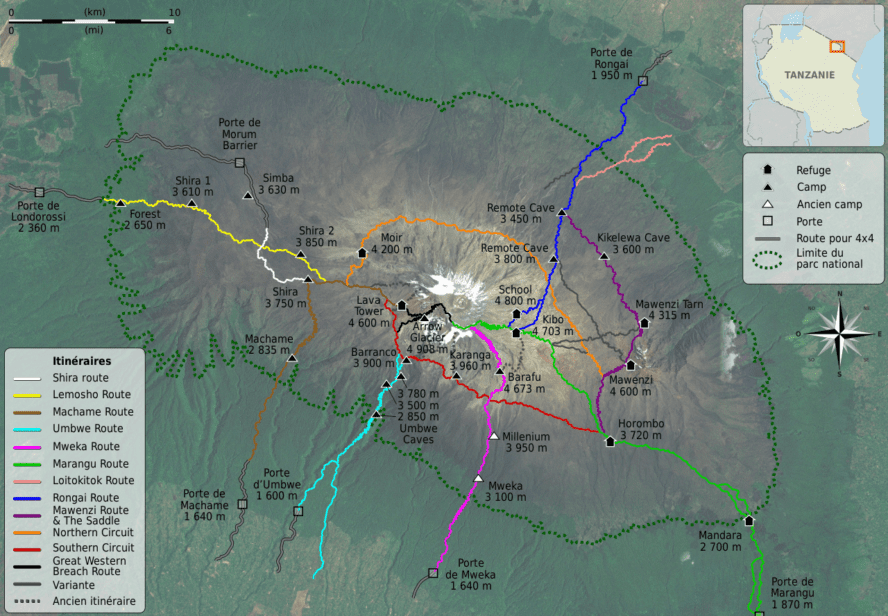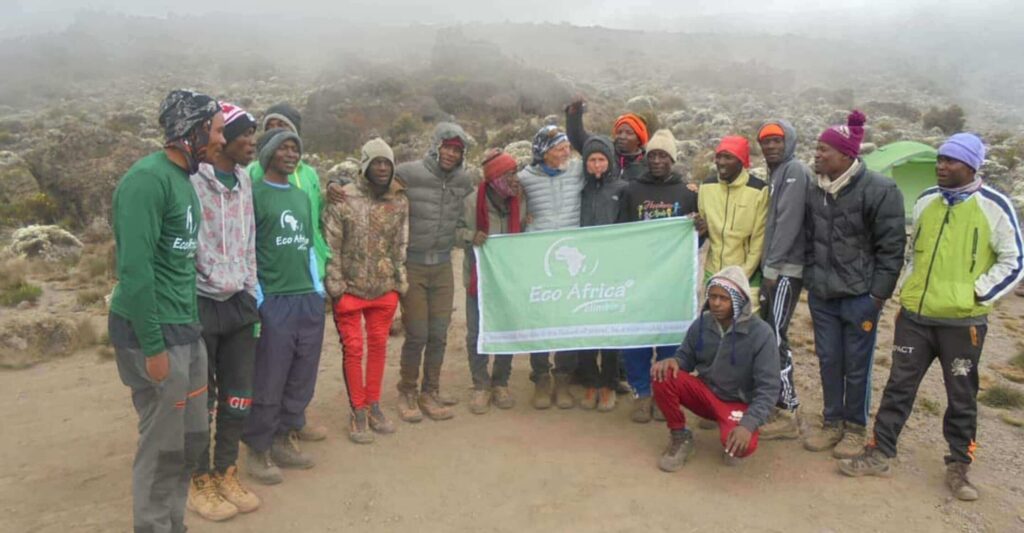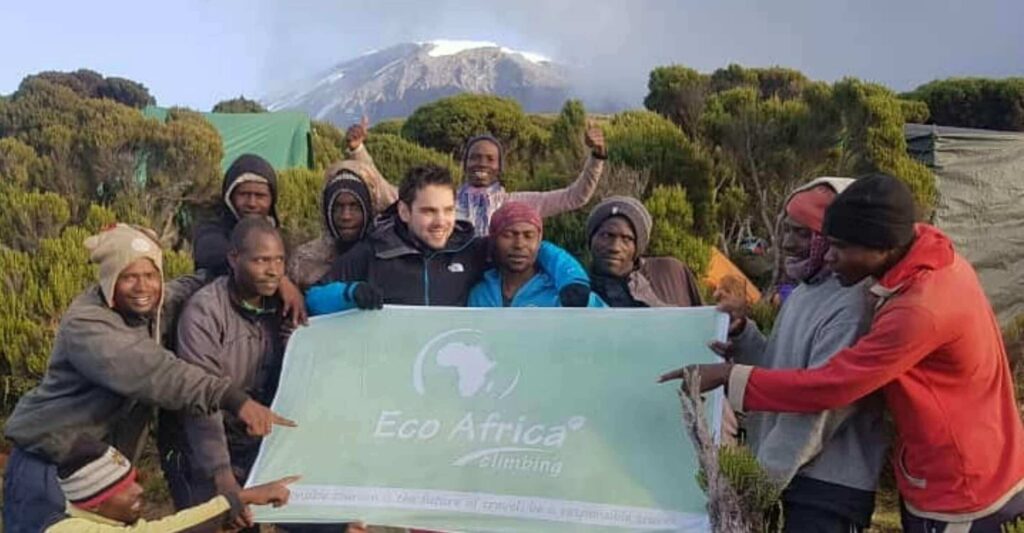Kilimanjaro Route Map: A Complete Guide to Choosing Your Climbing Path

Photo courtesy of Wikimedia Commons licensed under CC-BY-SA-3.0
Introduction
Climbing Mount Kilimanjaro isn’t just about reaching the summit—it’s about choosing the right route that matches your fitness, goals, and expectations. With several official routes available, each offering unique landscapes, durations, challenges, and success rates, selecting the best one can feel overwhelming. That’s where a comprehensive Kilimanjaro route map comes in handy.
This guide will walk you through each major route to Uhuru Peak, using clear, descriptive route maps and insights from Eco-Africa Climbing—one of the most trusted, KPAP-certified local operators in Tanzania. Whether you’re a beginner hiker or seasoned trekker, this article will help you understand which path up the mountain is best for you and why the map matters more than you think.
Where is Kilimanjaro and How Do the Routes Differ?
Mount Kilimanjaro is located in northeastern Tanzania near the border with Kenya. It rises dramatically from the surrounding plains and consists of three volcanic cones: Kibo, Mawenzi, and Shira. Uhuru Peak, located on Kibo, is the summit and the ultimate goal for climbers.
When viewed on a map, Kilimanjaro resembles a dome surrounded by trails that ascend from various directions, all eventually converging toward the crater rim. Some routes approach from the west, some from the south, and one from the north. Each route offers different perspectives, terrain types, and lengths, which significantly impact your acclimatization and summit success.
Map Overview: Major Routes to Uhuru Peak
Below are the primary climbing routes on Kilimanjaro that appear on most route maps. Click each link to explore the full itinerary:
- Lemosho Route (7–8 days) – Long, scenic, excellent for acclimatization.
- Machame Route (6–7 days) – Popular “Whiskey Route” with stunning views.
- Northern Circuit Route (8–9 days) – Longest and quietest route with 360° views.
- Rongai Route (6–7 days) – Drier, less crowded, approaches from the north.
- Marangu Route (5–6 days) – Known as “Coca-Cola Route,” the only hut route.
- Umbwe Route (6 days) – Steep, direct, and challenging.
- Shira Route (7 days) – Similar to Lemosho but starts at higher elevation.
While all trails lead to Uhuru Peak, the journey, difficulty, and experience vary dramatically. Your choice affects everything from your scenery to your acclimatization strategy to your chances of summiting successfully.
Reading the Kilimanjaro Route Map: What to Look For
A Kilimanjaro route map will typically show trail starting points (gates), overnight camps, elevation changes, and where different routes merge. Here are key things to analyze:
- Approach Direction: Western routes (Lemosho, Shira) offer gradual elevation gain. Northern routes (Rongai, Northern Circuit) are dry and remote.
- Convergence Zones: Most routes meet at Barafu Camp or Kibo Hut before the final summit push.
- Elevation Gain: Check if the route climbs too fast. Slow gain = better acclimatization.
- Exit Gates: Nearly all routes descend via Mweka Gate, regardless of where they start.
Understanding the map lets you visualize how long you’ll be on the mountain, where you’ll rest, and how your body will adjust to the altitude. This knowledge is key to choosing the best route for your success.
Kilimanjaro Route Map Image
To help you visualize these routes, here’s a high-quality Kilimanjaro route map image showing major trailheads and summit paths:

Photo courtesy of Wikimedia Commons licensed under CC-BY-SA-3.0
For a breakdown of what each trail offers, continue to the next sections where we’ll go route by route—day by day—using map references to help you plan.
Lemosho Route Map Overview
The Lemosho Route is one of the most scenic and highly recommended trails on Kilimanjaro. It starts on the western side of the mountain and offers an ideal combination of low traffic, breathtaking landscapes, and great acclimatization.
It typically takes 7 to 8 days, giving your body time to adjust to the altitude while maximizing your summit success chances. The route joins Machame at Shira Camp and then follows the southern circuit to the summit via Barafu Camp.
Lemosho Route Itinerary (Map-Based Highlights)
- Day 1: Lemosho Gate to Mti Mkubwa
- Day 2: Mti Mkubwa to Shira Camp 1
- Day 3: Shira 1 to Shira 2 Camp
- Day 4: Shira 2 to Lava Tower, then down to Barranco Camp (acclimatization)
- Day 5: Barranco to Karanga Camp
- Day 6: Karanga to Barafu Camp
- Day 7: Summit night: Barafu to Uhuru Peak and descend to Mweka Camp
- Day 8 (optional): Mweka Camp to Mweka Gate
Map Tip: Lemosho provides gradual elevation gain and crosses some of the most remote zones of the mountain early on.
Machame Route Map Overview
Known as the “Whiskey Route,” the Machame Route is one of the most popular options for a reason—it’s scenic, adventurous, and offers solid acclimatization through the climb-high-sleep-low approach.
Typically completed in 6 or 7 days, it starts from the south and connects with the Lemosho and Shira Routes at Shira Plateau, then follows the southern circuit.
Machame Route Itinerary
- Day 1: Machame Gate to Machame Camp
- Day 2: Machame Camp to Shira Camp
- Day 3: Shira to Lava Tower, then down to Barranco Camp
- Day 4: Barranco to Karanga Camp
- Day 5: Karanga to Barafu Camp
- Day 6: Summit to Uhuru Peak, then descend to Mweka Camp
- Day 7: Mweka Camp to Mweka Gate
Map Note: Machame route covers diverse terrain and vegetation zones, making it a visually rich route.
Northern Circuit Route Map Overview
The Northern Circuit is the longest and quietest route up Kilimanjaro, starting from the west (like Lemosho) and circling around the mountain’s northern slopes before joining the summit route at Kibo.
With a 9-day itinerary, it offers the best acclimatization and highest summit success rate. Ideal for trekkers who want more solitude and time on the mountain.
Northern Circuit Itinerary
- Day 1: Lemosho Gate to Mti Mkubwa
- Day 2: Mti Mkubwa to Shira 1 Camp
- Day 3: Shira 1 to Shira 2 Camp
- Day 4: Shira 2 to Moir Hut
- Day 5: Moir Hut to Buffalo Camp
- Day 6: Buffalo to Third Cave Camp
- Day 7: Third Cave to Kibo Hut
- Day 8: Summit to Uhuru Peak, then descend to Mweka Camp
- Day 9: Mweka Camp to Mweka Gate
Map Benefit: You cover the mountain’s northern flank, which is rarely seen by most trekkers.
Rongai Route Map Overview
The Rongai Route is the only trail that approaches Kilimanjaro from the north, near the Kenyan border. It’s much drier and less crowded than the southern routes and ideal for climbs during the wet season.
Rongai Route Itinerary
- Day 1: Rongai Gate to Simba Camp
- Day 2: Simba to Second Cave
- Day 3: Second Cave to Kikelewa Camp
- Day 4: Kikelewa to Mawenzi Tarn
- Day 5: Mawenzi Tarn to Kibo Hut
- Day 6: Summit to Uhuru Peak, then to Horombo Hut
- Day 7: Horombo Hut to Marangu Gate
Map Feature: This route allows for a quieter, off-the-beaten-path experience with less rain and fewer trekkers.
Marangu Route Map Overview
The Marangu Route is the oldest and only Kilimanjaro route offering hut accommodations instead of tents. Known as the “Coca-Cola Route,” it’s also the shortest and most direct path to the summit, which makes it appealing for some—but risky in terms of acclimatization.
It ascends and descends via the same trail, which leads to more foot traffic. The trail is scenic but less varied than other routes.
Marangu Route Itinerary
- Day 1: Marangu Gate to Mandara Hut
- Day 2: Mandara to Horombo Hut
- Day 3: Acclimatization day at Horombo
- Day 4: Horombo to Kibo Hut
- Day 5: Summit to Uhuru Peak, descend to Horombo Hut
- Day 6: Horombo Hut to Marangu Gate
Map Observation: Marangu’s straight path offers fewer acclimatization opportunities. It’s best suited for trekkers on tight schedules or those who prefer hut lodging.
Umbwe Route Map Overview
The Umbwe Route is the most challenging and direct trail up Kilimanjaro. It is very steep from the start and recommended only for experienced trekkers with strong fitness and altitude experience.
Despite its difficulty, it merges with the Machame route at Barranco Camp, allowing for decent acclimatization from day 3 onwards.
Umbwe Route Itinerary
- Day 1: Umbwe Gate to Umbwe Camp
- Day 2: Umbwe Camp to Barranco Camp
- Day 3: Barranco to Karanga Camp
- Day 4: Karanga to Barafu Camp
- Day 5: Summit to Uhuru Peak, descend to Mweka Camp
- Day 6: Mweka Camp to Mweka Gate
Map Note: Umbwe’s steep, quick ascent increases the risk of AMS. It’s best suited for veterans looking for a tough route with solitude.
Shira Route Map Overview
The Shira Route is similar to Lemosho but starts at a much higher elevation (Shira Gate at 3,500m), which can make the first night tricky for acclimatization.
It crosses the Shira Plateau and joins the Machame Route at Shira 2 Camp. While the scenery is beautiful, the initial altitude may increase the risk of AMS.
Shira Route Itinerary
- Day 1: Londorosi Gate to Shira 1 Camp
- Day 2: Shira 1 to Shira 2 Camp
- Day 3: Shira 2 to Barranco via Lava Tower
- Day 4: Barranco to Karanga Camp
- Day 5: Karanga to Barafu Camp
- Day 6: Summit to Uhuru Peak, descend to Mweka Camp
- Day 7: Mweka Camp to Mweka Gate
Kilimanjaro Route Difficulty and Success Rates
Each route varies in difficulty and success rate. Let’s look at a quick map-based comparison:
| Route | Duration | Difficulty | Success Rate |
|---|---|---|---|
| Lemosho | 7–8 Days | Moderate | 90–95% |
| Machame | 6–7 Days | Challenging | 85–90% |
| Northern Circuit | 8–9 Days | Moderate | 95%+ |
| Rongai | 6–7 Days | Moderate | 85% |
| Marangu | 5–6 Days | Easy to Moderate | 70–75% |
| Umbwe | 6 Days | Hard | 60–70% |
| Shira | 7 Days | Moderate | 80–85% |
Choosing a route with a longer duration is the most important factor for increasing your success rate. Slow and steady really does win the race on Kilimanjaro.
What Is the Best Route on Kilimanjaro?
If you’re serious about summiting Kilimanjaro safely and having the best experience possible, the best overall route is the Lemosho Route. Here’s why:
- It offers excellent acclimatization with a gradual ascent profile.
- You get to experience Kilimanjaro’s western wilderness and Shira Plateau.
- The views are mind-blowing, with fewer crowds in early days.
- Higher summit success rates—especially on the 8-day version.
Add to that the expert guidance and safety-first culture from a local KPAP-partnered operator like Eco-Africa Climbing, and you’ve got the most rewarding and responsible way to climb Africa’s highest mountain.
Final Word: Plan Your Route with Purpose
The Kilimanjaro Route Map isn’t just a guide—it’s your blueprint to summit success. Whether you’re looking for solitude, scenic beauty, or the most efficient acclimatization, one route will always rise above the rest based on your goals. But if you’re after the best balance of all elements—go Lemosho, and go with the best local partner on the mountain: Eco-Africa Climbing.
Helpful Resources for Climbing Kilimanjaro
- Compare All Kilimanjaro Routes
- What to Pack for Kilimanjaro
- Altitude Sickness on Kilimanjaro
- Best Time to Climb Kilimanjaro
- Why Choose Eco-Africa Climbing
- Contact Eco-Africa Climbing
FAQs About Kilimanjaro Routes
Which Kilimanjaro route has the highest success rate?
The Northern Circuit and 8-day Lemosho Route offer the highest summit success rates (90–95%).
Which route is best during the rainy season?
The Rongai Route is the driest and best during April, May, or November.
Do all routes lead to the same summit?
Yes, they all lead to Uhuru Peak—just from different approaches.
Can I change my route last minute?
It’s possible, but subject to permit availability. Plan early with Eco-Africa Climbing for the best experience.
Where can I see a real Kilimanjaro route map?
You can view a detailed Kilimanjaro route map on this comparison page.
Conclusion: Let the Map Guide Your Mission
Your Kilimanjaro success begins with a map—but it ends with the right guide. Choose a route that aligns with your physical readiness, your timeline, and your spirit of adventure. And most importantly, climb with a team that values your safety, supports local porters ethically, and delivers exceptional service.
That’s why climbers choose Eco-Africa Climbing.
Our Top Recommended Ethical Kilimanjaro Climbs
Ethical Kilimanjaro via Northern Circuit Route 9 Days
The Northern Circuit route is one of the best routes on Kilimanjaro.The route approaches Mount Kilimanjaro from the west….
From USD $3250
Ethical Kilimanjaro via Lemosho Route 8 Days
The Lemosho route is one of the newer routes on the mountain and a superb choice for your climb, It is our preferred route…
From USD $2950
Ethical Kilimanjaro via Machame Route 7 Days
Machame (“Whiskey”) Route is also known as the “Whiskey” route, the Machame route is now the most popular route on the …
From USD $2650


